On Victoria Day weekend, myself, accompanied with a few friends headed off on a road trip to Boston, passing through several Upstate New York cities on the way there, and through New Hampshire and Vermont on the way back. In this first installment, I highlight some of the interesting characteristics of three Upstate New York cities – Syracuse, Albany, and Troy.
Syracuse
Syracuse has a population of only 150,000, and a regional population of about 450,000, or approximately the same size of Kitchener-Waterloo or London, Ontario, yet many mid-sized American cities have architecture that appears much more impressive than what would be found in a similarly sized Canadian city.
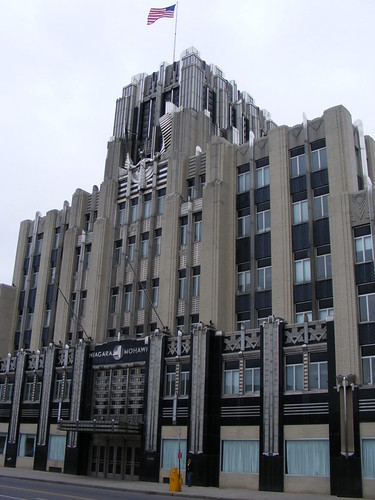
The Niagara-Mohawk building
The Erie Canal once passed straight through Downtown Syracuse – a later diversion bypassed the central city. Clinton Square now features an interesting reflecting pool that echoes the canal’s original path and with patios and public art and monuments, is a nice civic focal point.
Syracuse’s strangest attraction is an upside down traffic light, with red at the bottom, in the Tipperary Hill neighbourhood. A nearby monument explains the story. The local Irish community (drawn here after constructing the Erie Canal) refused in the late 1920s to accept a traffic light in their community where “British Red” was on top of “Irish Green.” After several attempts to destroy the new light, the city gave in. It’s quite the hazard for colour-blind drivers, and no signs warned of this unusual traffic light configuration.
Albany
I had heard of Albany’s giant New York State government complex, Empire State Plaza, but was both impressed and shocked by its gigantic scale. A plaza is surrounded by seven office buildings, with a state museum (with an Orwellian name of State Center for Cultural Education) on one end and the historic State House on the other side. In addition, there’s a performance hall in the “Egg”, so named because of its shape. The complex makes one think of what would happen if Le Corbusier and Frank Lloyd Wright joined forces and built a corporate city.
The tallest building at Empire State Plaza, the Corning Tower, has a public observation deck, but to get in there, one must follow a strange bureaucratic maze. The guard at the elevator at the lobby instructed us to go downstairs, and into the underground city that I did not know existed. At the information desk, we had to show ID and get a bad black-and-white photo taken on a temporary pass. We then went back upstairs, showed our cheap Avery labels to the guard, and went up.
Once up there, the smallness of Albany was apparent. The old inner city quickly gives way to sprawl, and then green forests. But the amount of land given to freeway interchanges and parking garages was enormous — and I wondered how much of the old city was cleared for this massive government complex.
Interstate 787 and a freeway spur into Empire State Plaza’s many parking garages are the focal point of Albany’s riverfront.
Interesting, a block or two from the State House and Empire Plaza, the otherwise attractive downtown has considerable blight. Perhaps the underground mall at Empire Plaza drains the downtown of needed life.
Troy
The last stop before crossing the Massachusetts state line was the City of Troy, only a few minutes north of Albany. I’ve heard of Troy mostly thanks to James Howard Kunstler’s website. (In May, Kunstler, who lives just north in Saratoga Springs, declared Troy City Hall that month’s eyesore.) Troy’s downtown is remarkably intact, and relatively vibrant for a small city centre. One of my friends remarked that this city was in a way, a microcosm of New York City, particularly the outer boroughs. He was indeed right, as we saw brownstones and grand banking halls, Victorian commercial blocks, and even, on the way out of town, brick housing towers that wouldn’t look out of place beside the Brooklyn or Williamsburg Bridge. The necessity of crossing the Hudson River to get into town was also a nice touch.
Kunstler’s eyesore city hall. I don’t hate it — it’s rather tame brutalism in a city that has little modern architecture. It is not much larger than any of its surrounding buildings and fits at least the scale, if not the context (I’ll leave my criticisms of brutalist city halls for when I get to Boston).

(Photo by L. Machler)
I also wonder how many people, even on road trips, take the chance to get off the highway and see some of the towns along the way. I once drove between Detroit and Chicago, and avoided Interstate 94 almost the whole way to see many of the interesting cities and towns along the way. Unfortunately, off and on rain limited the number of pictures I could take.
Next: Downtown Boston and the Big Dig


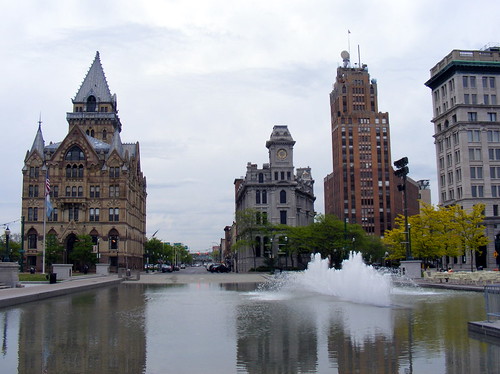
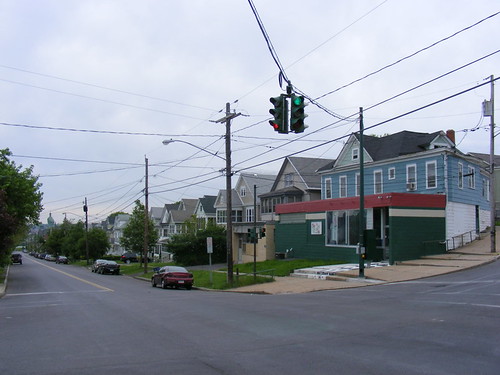
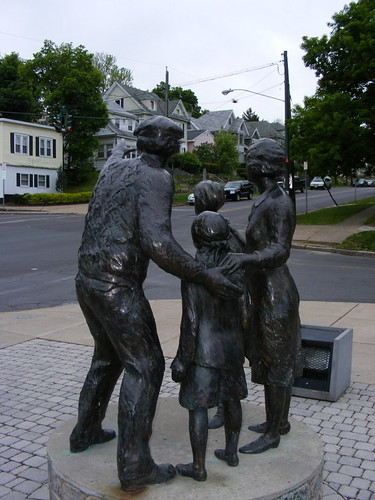
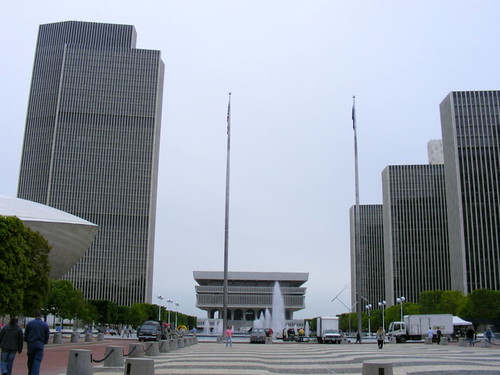
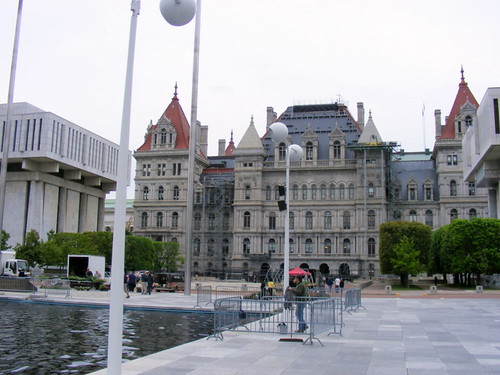

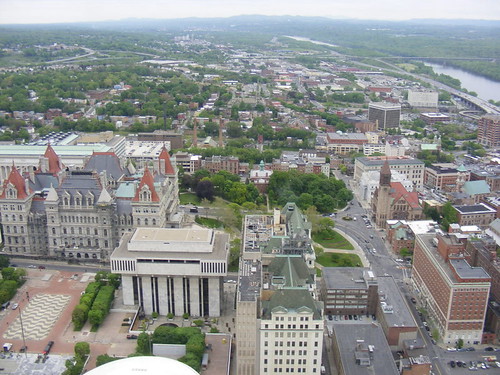
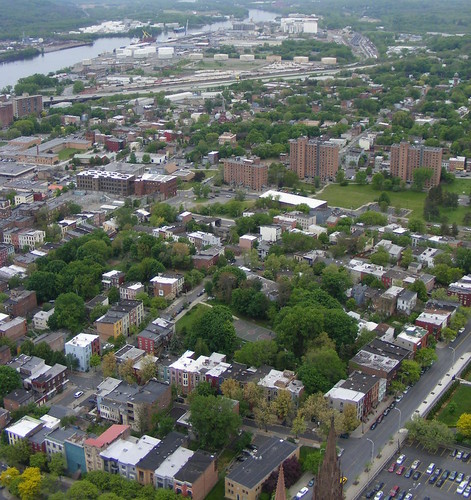



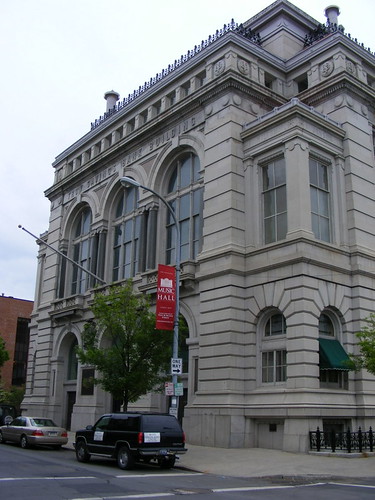
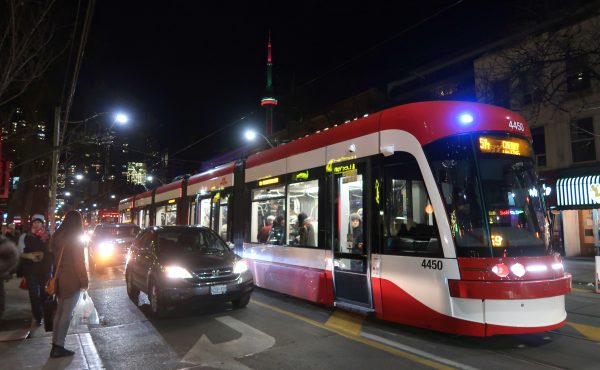
10 comments
Thanks for posting – there are some great towns and cities once you get off the interstate and poke around.
Indeed, so many towns and cities in upstate NY, including Buffalo, are built so well, and like do feel a bit New Yorkish. You begin to feel “The Empire State” even if the cities have had the economic wind taken out of their sails.
I don’t find Kunstler’s eyesores particularly interesting much of the time. He seems driven by an architectural ideological agenda, and his writing is so angry and contemptuous, it’s hard to read. There are good ideas there, but I don’t feel like digging through angry-old-man to find them.
Of course, the difference btw/a Syracuse and a K-W or London is that the Syracuse region is about the same size now, and the city smaller, than half a century ago–while London and K-W must be at least double their half-century-ago size…
It always seems a bit sad to me that such a stock of great buildings wasn’t enough to keep these cities from fading.
Kitchener-Waterloo is definitely at a different stage in the cycle: it may not have a Clinton Square, but Syracuse doesn’t have a Perimeter Institute.
These were once very wealthy cities due to the Erie Canal, in the way that Hong Kong and other great ports are wealthy today. In 1830 Troy was the 19th largest city in America. In 1850 Troy was still 25th while Syracuse had risen to 27th. After that it was all downhill as the railroads sapped the Erie’s importance.
By 2000 Syracuse had fallen to 141st. They still have some amazing old buildings but no longer have the people or jobs to fill them, and the city is filled with abandoned or bulldozed houses.
Troy started falling in prominence much earlier, and somehow managed to find its niche much better. Haven’t been there but looks interesting.
Albany is just plain weird, having been urban-renewal-ed out of existence in the 1960s. Slums, blight, 70 story skyscrapers, more expressways than GM could dream of — all in a one-horse town that has no function other than government, and the single most inefficient, bloated, dysfunctional state government at that. The post-5 pm options are limited, since everyone flees as soon as they can. Odd, odd place.
By the way, median home price in Troy-Albany last year: $199,000.
And the funny thing is, that viewed-overhead Albany zone of walkups and brownstones to the SE of ESP actually looks very comfy and liveable–even those (presumably) “project” towers don’t detract.
It’s at moments like that when I’m reminded of how pathological the US attitude t/w urbanism became over the past 50 years; even that which was reviled didn’t need to become so dysfunctional…
“the amount of land given to freeway interchanges and parking garages was enormous”
It is amazing that so much of North America, especially the United States, has given so much real estate over to the automobile. Then they becomes a ghost town on the weekends.
Thousands of homes were torn down and the city’s entire Italian neighborhood were torn to bits just to build the state office complex. The freeway interchanges did even more damage.
But they’re needed, since they’re the big arteries that take the state workers from their offices to their homes in the suburbs and exurbs.
By the way, part of the “considerable blight” visible from the Corning Tower is the aftermath of a 2006 fire in one of the prettier residential blocks across the street from the governor’s mansion. I think that the buildings haven’t been restored due to various issues between the city, historic preservationists, and landlords. But I don’t live in that area and I don’t know the whole story.
although i now live in toronto, i grew up near Albany. I know all of these cities rather well, in addition to a number of other Mohawk valley gems.
Upon your next visit, I highly recommend stops in Utica, Amsterdam and Schenectady–all single industry towns which have been in steady decline since the before WWII.
There have been a seemingly never ending set of schemes to restore their former civic glory, mostly in the form of malls, parking lots, convention centers and government money throw at dying industries.
Although urban renewal projects ravaged a number of US cities in the 60’s and 70’s, locales such as these were completely obliterated.
Utica and Amsterdam are the best specimens. The bare streets and sour faces of the populace can only be matched with what I saw on the streets of Pyongyang. And as in Pyongyang, architectural gems abound, although the eerie lack of street life makes it difficult to imagine for whom these structures were built. The only major difference is that in Pyongyang, the city is actually relatively viable and well planned.
As a final note, if you ever pass through Prescott on the 401, head across the river to a town called Ogdensburg, NY. A city modernized in the 60’s for the Seaway riches that never came.